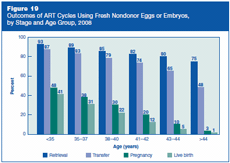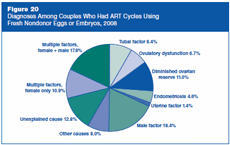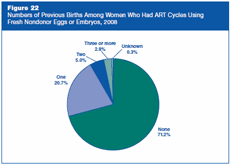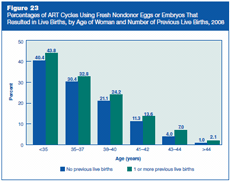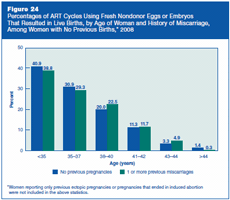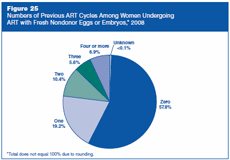Section 2: ART Cycles Using Fresh, Nondonor Eggs or Embryos (Part B)
Because of the large size of Section 2 it is broken up into three parts.
Part B contains Figures 16–26.
How do percentages of ART cycles that result in pregnancies, live births, and singleton live births differ for women who are 40 or older?
Percentages of ART cycles that result in pregnancies, live births, and singleton live births decline with each year of age and are particularly low for women aged 40 or older. Figure 16 shows percentages of pregnancies, live births, and singleton live births in 2008 for women aged 40 or older who used fresh nondonor eggs or embryos. The average chance for pregnancy was about 27% for women age 40; the percentage of ART cycles resulting in live births for this age was about 18%, and the percentage of ART cycles resulting in singleton live births was 14%. All percentages dropped steadily with each 1-year increase in age. For women older than 44, the percentage of live births and singleton live births were both close to 1%. Women aged 40 or older generally have much higher percentages of live births using donor eggs (see Figure 47).
A woman’s age not only affects the chance for pregnancy when her own eggs are used, but also affects her risk for miscarriage. Figure 17 shows percentages of ART cycles started in 2008 that resulted in miscarriage for women of different ages. Percentages of ART cycles that resulted in miscarriage were below 14% among women younger than 35. The percentage of ART cycles that resulted in miscarriages began to increase among women in their mid- to late 30s and continued to increase with age, reaching 30% at age 40 and almost 58% among women older than 44.
The risk for miscarriage observed among women undergoing ART procedures using fresh nondonor eggs or embryos appears to be similar to those reported in various studies of other pregnant women in the United States.
The risk for pregnancy loss (loss of an entire pregnancy or all fetuses in a multiple-fetus pregnancy, including stillbirths and miscarriages) is affected by the duration of a woman’s pregnancy and her age. Figure 18 shows that 12% to 57% of clinical pregnancies (see Pregnancy [clinical] in Glossary of Terms) were lost through 24 weeks gestation, depending on the woman’s age. Among women younger than 35, 12% of pregnancies were lost and 87% continued through week 24. In contrast, among women older than 44, 57% of pregnancies were lost and only 41% continued through week 24. In all age groups, most pregnancy losses occurred before week 14 (i.e., during the first trimester). The risk for pregnancy loss after 24 weeks was less than 1% for all age groups because most pregnancies that progress beyond week 24 lead to live births. Note that percentages of pregnancy loss and percentages of pregnancy continuation for each age group may not add up to 100% because some pregnancies resulted in outcomes other than pregnancy loss before week 24 (e.g., live births before 24 weeks gestation, induced abortions, or maternal death).
In 2008, a total of 104,673 cycles using fresh nondonor eggs or embryos were started:
- 43,296 among women younger than age 35
- 23,326 among women aged 35–37 years
- 21,793 among women aged 38–40 years
- 9,783 among women aged 41–42 years
- 4,907 among women aged 43–44 years
- 1,568 among women older than age 44
Figure 19 shows that a woman’s chance of progressing from the beginning of ART to pregnancy and live birth (using her own eggs) decreases at every stage of ART as her age increases.
- As women get older, the likelihood of a successful response to ovarian stimulation and progression to egg retrieval decreases.
- As women get older, cycles that have progressed to egg retrieval are slightly less likely to reach transfer.
- The percentage of cycles that progress from transfer to pregnancy also decreases as women get older.
- As women get older, cycles that have progressed to pregnancy are less likely to result in a live birth because the risk for miscarriage is greater (see Figure 17).
Figure 20 shows the infertility diagnoses reported among couples who had an ART procedure using fresh nondonor eggs or embryos in 2008. Diagnoses range from one infertility factor in one partner to multiple factors in either one or both partners. However, diagnostic procedures may vary from one clinic to another, so the categorization also may vary.
- Tubal factor means that the woman’s fallopian tubes are blocked or damaged, making it difficult for the egg to be fertilized or for an embryo to travel to the uterus.
- Ovulatory dysfunction means that the ovaries are not producing eggs normally. Such dysfunctions include polycystic ovary syndrome and multiple ovarian cysts.
- Diminished ovarian reserve means that the ability of the ovary to produce eggs is reduced. Reasons include congenital, medical, or surgical causes or advanced age.
- Endometriosis involves the presence of tissue similar to the uterine lining in abnormal locations. This condition can affect both fertilization of the egg and embryo implantation.
- Uterine factor means a structural or functional disorder of the uterus that results in reduced fertility.
- Male factor refers to a low sperm count or problems with sperm function that make it difficult for a sperm to fertilize an egg under normal conditions.
- Other causes of infertility include immunological problems, chromosomal abnormalities, cancer chemotherapy, and serious illnesses.
- Unexplained cause means that no cause of infertility was found in either the woman or the man.
- Multiple factors, female only, means that more than one female cause was diagnosed.
- Multiple factors, female and male, means that one or more female causes and male factor infertility were diagnosed.
Figure 21 shows the percentage of ART cycles that resulted in live births according to the causes of infertility. (See Figure 20, or the Glossary of Terms in Appendix B for an explanation of the diagnoses.) Although the national average was about 30% (see Figure 8), the percentage of ART cycles that resulted in live births varied somewhat depending on the couple’s diagnosis. In 2008, the percentage of ART cycles resulting in live births was higher than the national average for couples diagnosed with tubal factor, ovulatory dysfunction, endometriosis, male factor, or unexplained infertility; it was lower for couples diagnosed with diminished ovarian reserve, uterine factor, “other” causes, or multiple infertility factors. Please note, however, the definitions of infertility diagnoses may vary from clinic to clinic and that a review of select clinical records revealed that reporting of infertility causes may be incomplete. (See Findings from Validation Visits for 2008 ART Data in Appendix A.) Therefore, differences in success rates by causes of infertility should be interpreted with caution.
Figure 22 shows the number of previous births among women who had ART procedures using fresh nondonor eggs or embryos in 2008. Most of these women (71%) had no previous births, although they may have had a pregnancy that resulted in a miscarriage or an induced abortion. About 21% of women using ART in 2008 reported one previous birth, and about 8% reported two or more previous births. However, we do not have information about how many of these were ART births and how many were not. These data nonetheless point out that women who have previously had children can still face infertility problems.
Do women who have previously given birth have higher percentages of ART cycles that result in live births?
Figure 23 shows the relationship between the success of an ART cycle and the woman’s history of previous births. Previous live-born infants were conceived naturally in some cases and through ART in others. In all age groups, women who had a previous live birth were more likely to have a successful ART procedure.
Is there a difference in percentages of ART cycles that result in live births between women with previous miscarriages and women who have never been pregnant?
In 2008, 74,512 ART cycles were performed among women who had not previously given birth. However, about 28% of those cycles were reported by women with one or more previous pregnancies that had ended in miscarriage—we do not have information on whether these pregnancies ending in miscarriage were the result of ART or were conceived naturally. Figure 24 shows the relationship between the success of an ART cycle and the history of previous miscarriage. In all age groups, women who had a previous miscarriage were about as likely to have a live birth as women who had never been pregnant. Thus, a history of unsuccessful pregnancy does not appear to be associated with lower chances for success during ART.
Figure 25 presents ART cycles that used fresh nondonor eggs or embryos in 2008 according to whether previous ART cycles had been performed. For about 42%, one or more previous cycles were reported. (This percentage includes previous cycles using either fresh or frozen embryos.) This finding illustrates that it is not uncommon for women to undergo multiple ART cycles. We do not have information on when previous cycles were performed, nor do we have information on the outcomes of those previous cycles.
Are percentages of ART cycles that result in live births different for women using ART for the first time and women who previously used ART but did not give birth?
Figure 26 shows the relationship between the success of ART cycles performed in 2008 using fresh nondonor eggs or embryos and a history of previous ART cycles among women with no previous births. In most age groups, percentages of ART cycles that resulted in live births were lower for women who had previously undergone an unsuccessful ART cycle.
Contact Us:
- Centers for Disease Control and Prevention
1600 Clifton Rd
Atlanta, GA 30333 - 800-CDC-INFO
(800-232-4636)
TTY: (888) 232-6348 - New Hours of Operation
8am-8pm ET/Monday-Friday
Closed Holidays - cdcinfo@cdc.gov



